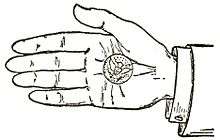Palming
For the basketball violation colloquially known as "palming", see Carrying (basketball).

Palming a coin, from early-20th century writings on magic by Ellis Stanyon.
Palming is a technique for holding or concealing an object in the palm of the hand. It is used frequently by magicians to conceal the presence of a card, coin, or other object. When it is done skillfully, the hand containing the palmed object appears to be completely empty.
Methods
Methods for palming differ depending on the object intended to be concealed.
- Card palms
- A card palm is any method for taking out or holding out one or more cards from the deck. Cards can be taken from the top, bottom, or middle of the deck. The cards palmed must be concealed completely from view, and the magician using the palm must not let any space between his fingers. Proper technique for holding the card in the palm indicates that(assuming a faced down card) that the card is flat against the hand, and held by the third joint of the pinky and the fleshy base of the thumb. This leaves the rest of the fingers of the hand to adjust to look natural. Though there are innumerable methods for palming cards out of or off of the deck, the one that is best known to magicians is Dai Vernon's Topping the Deck which appeared in The Dai Vernon Book of Magic. Vernon himself was quoted at several times as affirming the Erdnase top palm from S.W. Erdnase's 1902 book The Expert at the Card Table as the best palm ever devised, as it is truly deceptive, and can be used to palm off several cards at once. Topping the Deck achieves the palming of only one card. In order to make the action more natural, some palms involve cover actions, such as springing the cards, or transferring the deck from hand to hand. Some more esoteric palms, include Judson Cole's One Hand Top Palm, Erdnase's Diagonal Palm Shift, various palms from the action of riffle shuffling, and steals from the side of the deck.
- Coin palms
- The coin that is to be palmed is usually resting on the fingertips, on the fore and middle fingers of the hand. This position is quite flexible and will allow the coin to be easily maneuvered as the two fingers are curled into the palm or the hand is turned palm-downwards after curling the fingers to make a clenched fist. At that point, the coin is then pressed into the palm of the hand. Try to keep the thumb and forefinger touching, as that will prevent the thumb from sticking out, which would make it obvious that you are concealing a coin in the hand.
Uses
Palming an object generally allows for one of three effects to take place:
- Vanishing an object can be achieved by palming it. Used properly, the object will seem to have disappeared completely, and the performer's hands will appear to be empty. The palmed object can then be skillfully transferred to the opposite hand, or secretly disposed of, allowing the performer's hands to be shown as actually empty.
- Producing an object can also be achieved by palming it out of sight of the viewer, or after the object has been "vanished" into the palm. Proper handling can give the appearance of two empty hands, and can conceal the origin of the item.
- Transposing two different objects can be achieved by simultaneously releasing one item from a palm grip, while inserting another. In this way, a card or coin can be made to appear to change into a different type or color.
See also
References
This article is issued from Wikipedia - version of the 9/2/2016. The text is available under the Creative Commons Attribution/Share Alike but additional terms may apply for the media files.